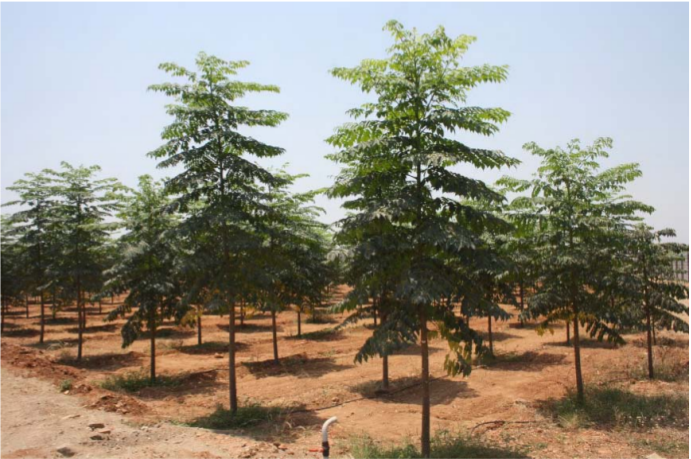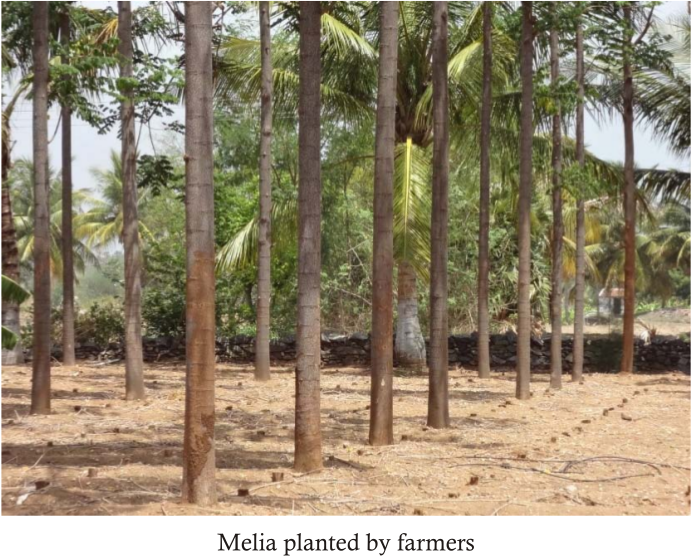Melia dubia
Melia dubia
The trees grow well in sandy loam, red and lateritic soils with an annual rainfall of 800 mm and above. .
Seed collection, processing and Nursery techniques
Seed processing and pretreatments: Reports state very poor germination in Melia. Studies at IFGTB reveal germination as high as 60 per cent without any pretreatments. The drupes should be graded in water to remove floating seeds prior to sowing.
Nursery:
Seed sowing: It is best to sow seeds during March – April. Cleaned and dried seeds should be sown in the open raised nursery beds, in drilled lines, 5 cm apart. Seeds do not germinate in sand. They have to be sown in soil: farm yard manure medium in the ratio 2:1. A 1:1 ratio can also be adopted. About 6-7 kg of dried drupes containing about 1500 numbers are required for one standard nursery bed. The seeds sown need to be watered regularly, twice a day. At places where daytime temperature is not very high, or where nursery beds are in shade, the bed should be covered with a tarpaulin sheet to retain temperature in the medium. Germination occurs within 90 days.
Vegetative propagation : Juvenile stem cuttings and coppice shoots respond well to 1000 – 2000 ppm IBA (liquid formulation). Coppice from older trees responds better to rooting. Pencil thick cuttings need to be taken for propagation. Thin shoots are easily susceptible to root rot. The shoots can be placed on sand medium and watered twice a day. A provision for drainage is a must as water logging destroys the shoots. Season also plays a major role in the rooting of cuttings. Drier seasons are conducive for rooting. About 75 per cent rooting can be obtained.
Note: The species is very sensitive to transplantation and hence care must be taken while prickling seedlings from bed or transplanting rooted shoots to bags.
Plantation management
A spacing of 5 x 5 m is optimal while a spacing of 8 x 8 m is ideal. Growth is enhanced with the application of fertilizers. Regular irrigation is required for fast growth of the trees. Initial growth is hastened with daily watering and application of fertilizers once in three months for the first three years. Under rainfed conditions, the growth is slow (almost 100 % less). The tree branches at 8-10 m from ground. Pruning every six months controls branching. The bole is straight, round, without any knots and without any buttress.
Agroforestry practices
Melia is a good agroforestry species and supports a variety of crops throughout its cultivation period. Ground nut, chilli, turmeric, blackgram, papaya, banana, melon, sugarcane, as inter crops are being successfully cultivated. The species performs exceedingly well when planted on bunds, attaining the harvestable size within four years.
Yield
The tree attains a volume of 15 cu. ft. at the end of 15 years and earns revenue of Rs. 350 per cubic foot from the 5th year onwards. Growth rate ranges from 20-25 cm per year when intensively managed and 6 to 8 cm per year in unmanaged plantations. It is expected to produce 12 to 15 Cuft. ( 0.4 - 0.5 cu.m) of timber in 5 years time. Presently Melia fetches Rs. 7300/- per tonne for billets of girth 50-120 cm girth and above Rs.370 per CFT (0.02 cu.m.) for trees which have attained a girth > 120 cm.
Uses
It is a good secondary timber and the most preferred species for plywood industry. The wood is also used for packing cases, ceiling planks, building purposes, agricultural implements, pencils, match boxes, splints, cattamarans, musical instruments and tea boxes as the wood is anti-termite by itself. Thus, the species has a ready and assured market due to its multipurpose utilities. The species is also highly adaptable. The species is in high demand by the plywood industries.


Source: Transfer of Tree Cultivation Technologies to Krishi Vigyan Kendras - Publication by Institute of Forest Genetics and Tree Breeding,Coimbatore.
Last Modified : 3/1/2020
This topic provides information related to cultiva...
This topic provides information about the cultivat...
This topic provides information related to cultiva...
This topic provides information related to cultiva...
